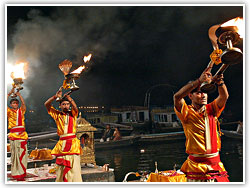|
|
Varanasi, Uttar Pradesh
.............................................................................................................................................................................. |
|
General Information on Varanasi
Population: 793,542 (1981)
Altitude: 81 m
Best time to Visit:
October to April
|
|
|
 |
 |
|
History of Varanasi
According to the legends, Varanasi was founded around
ten centuries before the birth of Christ. It was
probably already an important town by the 7th century BC
when Babylon and Nineveh were at the peak of their
power. The Buddha came to it in 500 BC. This city also
finds its place in various holy epics like Vamana Purana,
the Ramayana, the Mahabharata and in some of the
Buddhist texts. Varanasi was also known as "Avimuktaka",
"Anandakanana", "Mahasmasana", "Surandhana", "Brahma
Vardha", "Sudarsana", "Ramya", "Kasi",
"Kashi" and "Banaras". The earliest inhabitants of
Varanasi were the Aryans who contributed to its growth
as a great centre of culture, education, commerce and
craftsmanship. It was raided by Muhammad of Ghazni’s army in
1033. In 1194 Qutb-ud-din Ghori defeated the local
Raja’s army and Ala-ud-din Khalji, the King of Delhi
(1294-1316) destroyed temples and built mosques on their
sites, and for a brief period in the 18th century it was
known as Mohammadabad. Despite its early foundation
hardly any building dates before the 17th century and
few are more than 200 years old. Strikingly there have
been no archaeological finds of any antiquity at the
site.
Varanasi stands as the centre of Sanskrit learning in
northern India. Sanskrit, the oldest of the
Indo-European languages, is one of learning and
religious ritual and has been sustained here long after
it stopped being used as a living language elsewhere.
The Sanskrit University, for example, has over 150,000
rare manuscripts. Hindu devotional movements flourished
here, especially in the 15th century under Ramananda and
Kabir, one of India’s greatest poets lived in the city.
Tulsi Das translated the Ramayana from Sanskrit into
Hindi.
|
|
|
|
Festivals of
Varanasi
The city of Varanasi celebrates a number of
special festivals. During the first month of the
calendar, pilgrims perform the circumambulation of
Kasi Dharmakshetra, as laid down in the
scriptures. Ganga Dasara celebrates the day when
the waters of the Ganga reached Haridwar. Now.
Nagnathaiya at Tulsi Ghat enacts the story of
Krishna jumping into the Jamuna to overcome Kalia,
the king of the Serpents. Also a fair is held at
Chetganj to remember the occasion when
|
 |
|
|
Rama’s
brother Lakshman, cut off Ravana sister’s nose when she
attempted to force him into a marriage. At Nati Imli,
Bharat Milap, the meeting of Rama and Bharat after a
separation of 14 years is celebrated with great ceremony
with the Maharaja of Varanasi attending in full regalia,
on elephant back. Music festivals are mainly held in the
winter months between December and February.
Handicrafts of Varanasi
Varanasi has always been a centre of trade and commerce.
The place is also known for silk weaving, embroidery and
metalwork. Today Varanasi is famous for ornamental brass
work, silks and embroideries and for the manufacture of
glass beads, which are exported all over the world. The
significance of Silk in India’s traditional life is
deep-rooted. Silk was considered a pure fabric, most
appropriate for use on ceremonial and religious
occasions. Its luster, softness and richness of its
natural colour gave it precedence over all other
fabrics. White or natural coloured silk was worn by the
Brahmins and ‘twice born’. Women wore bright colours and
the darker hues were reserved for the Sudras or lowest
caste in the hierarchy. Silk garments were worn for
rites of passage like births and marriages, and
offerings of finely woven silks were made to deities in
temples. It has been suggested that this concept of
purity may have given impetus to the growth of
silk-weaving centres around ancient towns like
Kanchipuram, Varanasi, Bhubaneshwar and Ujjain, a
tradition that is kept alive today.
|
|
|
|